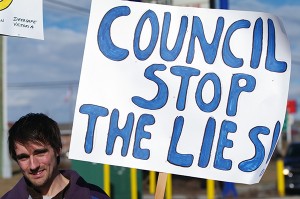The members of Invermere Deer Protection Society (IDPS) are disappointed the BC Supreme Court dismissed its petition challenging the District of Invermere on urban deer culling, it announced this morning (Oct. 29) in a press release.
The Supreme Court dismissal comes after two “difficult years of work and fundraising to facilitate hearing our public interest trial,” the IDPS noted.
IDPS president Devin Kazakoff at an anti deer cull protest in Cranbrook last winter. Ian Cobb/e-KNOW
“A dismissal, with judgment neither for nor against IDPS, indicates merely that our arguments were considered insufficient. Unfortunately, the judge disallowed two critical response affidavits that severely diminished our arguments,” the press release outlined, adding, “A survey expert wrote that the District of Invermere householder survey was unreliable as a gauge of public opinion. And the second affidavit, of a highly qualified B.C. ungulate biologist, stressed the critical requirement that real science be used in municipal decisions about wildlife management. There is ample case law to stress the importance decisions are based on science.”
Charles Lamphier, IDPS director and long-time Invermere resident said, “The fact these affidavits were not used in court is unfair. But we advise municipalities to continue to acknowledge they are not expert in social or biological sciences and therefore they should step back from unsupported lethal decisions.”
The IDPS stated it is not overly surprised with the decision “but we worry about the future of deer and other wildlife living in our municipalities. The fact that some municipalities have reconsidered and decided not to apply to the province for killing permits is a victory in itself.”
“Grand Forks decided to hold off on culling and do scientific study instead, something every municipality facing deer complaints should be doing,” said Kathy Wilson, member of IDPS.
The IDPS says it will continue advocating and supporting non-lethal deer management through education, research and political action – “to defeat the killing mentality and negative attitudes to wildlife the District of Invermere so vigorously defends.”
Closing its release, the IDPS urges residents to vote ‘no’ in the Nov. 2 poll, tacked onto the referendum asking residents if they favour borrowing $5.6 million for a new community centre.
For more on the IDPS: https://www.facebook.com/InvermereDeerProtectionSociety
